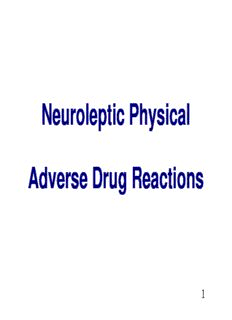
Neuroleptic Physical Adverse Drug Reactions PDF
Preview Neuroleptic Physical Adverse Drug Reactions
Neuroleptic Physical Adverse Drug Reactions 1 Contents: Neuroleptics and Antipsychotics 4 ………………………...……….……………………………………...…………....… Neuroleptic Adverse Drug Reactions and Pharmacogenetics 5 …………………..….… Neuroleptics and Neurotransmitters 7 …………………………………………………………..………...…………… Neuroleptic Iatrogenic Adverse Reactions: Body Movement Disorders 9 .….…………………………………………..………….…………………..…. …………..… Tardive Dyskinesia 10 ….…………………………………………………………....………….………..…….……..…………….. Parkinsonism 13 …………………………………..……………………………………………..………………………….…….…….…. Tardive Dystonia 15 ……..…………………………………...….…………………………………………………………....….……. Oculogyric Crisis 16 …………………………………………………………...……………………………………………………… Akathesia 19 ………………………………………………………...………………………………………….…………………..…….….… Endocrine Disorders 21 …………………………………………………………………………………………..……………………… Metabolic Syndrome 22 ……………………..…………………………………………………………..…………………….…… Sexual Dysfunction Male or Female 23 …………………………………………...…………………….....……… Osteoporosis 25 ……………………………..……….…………………………………………………………………………..…..….….. Disruption of Thyroid 26 …..……………………………………………………..…………..….…………………..……....…… 2 Contents continued… Cerebro-Vascular and Cardiac Disease 27 …………………………………………….…………………….…. Neuroleptic Malignant Syndrome 29 .………………………………………………….…………..…...………….…… Temperature Dysregulation 31 .………………………………………………………………………………………….……... Respiratory Disease 32 ………………………………………………………………………………………………………...………… Agranolocytosis 33 …………………………………………………………………………………………………………...……………..... Neuro-degenerative Brain Changes 34 …………………………………………..……….……………….…….……. Additional Neuroleptic Iatrogenic Adverse Reactions 37 …………………………..…….…... Sudden Unexplained Deaths 39 ……………………………..….…………………………………………………………..… Tardive Tourettism 43 ………………………………………………………………………………………………………………….… Conclusion 44 ……………………………………………….……………………………………………………………………………..….….… Ethics 45 …………………………………………………………………………………………………………….………………….……………….… Successful non Neuroleptic Treatments 46 …………………………………...………….…….…………….…. References 47 ………………………………………………………………………………………………………..…………………………….... 3 Neuroleptics and Antipsychotics The terms ‘antipsychotic’ and ‘neuroleptic’ are used interchangeably in research papers, although in clinical guidelines and practice, ‘antipsychotic’ is the most frequently used. Prior to these terms these medications were known as ‘Major Tranquillisers’. The term ‘neuroleptic’ was accepted in 1955 and eventually became known as ‘antipsychotic’ by drug companies who used it as a marketing ploy to influence doctors and patients to believe that the drug’s specific action was to treat and prevent psychosis. However this ploy puts considerable distance from numerous other ‘antipsychotic’ actions and the hard reality of what the drug does to the brain. Neuroleptic literally means to ‘seize the nerve’, a chilling scenario. For this reason, throughout this document the word ‘Neuroleptic’ will be used in place of ‘Antipsychotic.’ 4 Neuroleptic Adverse Drug Reactions and Pharmacogenetics Neuroleptic ADR are caused by the way the drugs act on neurons and neurotransmitters in the brain and body and are therefore IATROGENIC. i.e. neuroleptic induced. ADR are influenced by the genetically predetermined rate of metabolism known as Pharmacogenetics. When people have the in- born slower rates of metabolism i.e. Poor Metaboliser or an Intermediate Metaboliser Genotype profiles, neuro-toxicity increases which is associated with the severity of ADR. 1, 2 All people who take neuroleptics will be affected by various ADRs, either within a short or longer period of time. 60% of patients experience severe/very severe side effects.3 5 Adverse Drug Reactions and Side Effects In both patient and professional literature, to explain the ‘undesired effects of medication’, pharmaceutical companies commonly use the term ‘side effects’. Because the term both minimises and obscures the cause of ‘side effects’, the term is replaced by Adverse Drug Reactions (ADRs) in this document. Many neuroleptic physical ADRs are not found in mainstream literature. In order to readdress this situation, this document provides up to date and concise ADR information for mental health and social care practitioners. 6 Neuroleptics and Neurotransmitters It is well known that neuroleptic medication depletes dopamine by disrupting the dopamine neurotransmitters in the brain. What is not so well known is that atypical neuroleptic medication disrupts other neurotransmitters such as serotonin, adrenaline, noradrenaline and acetylcholine, that play an important role in the maintenance of all body systems. It is the balance between all of the neurotransmitters that is important and this balance is in constant flux to maintain long term stability. If the level of one neurotransmitter is artificially raised or lowered by medication, all other neurotransmitters are relatively affected and stability is lost. Unnatural interference with neurotransmitters by neuroleptics causes deterioration of physical health and leads to various iatrogenic illnesses. 7 Physical Functions of Dopamine Dopamine as a neurotransmitter: Co-ordination of voluntary and involuntary movements and muscular strength. Participates in thermoregulation and regulates metabolism. Enables the natural regulation of fat and sugar, sleep patterns, control of hunger, thirst, fatigue, and circadian cycles. Dopamine as an endocrine neurohormone: Participates in the regulation of blood pressure, heart rate, cardiac output, fluid and sodium balance, gastric motility, lactation, fertility, and bone strength.4 Enables the flight and fight responses in the face of danger.5 8 Introduction to Body Movement Disorders The Extra Pyramidal System in the brain controls normal body movements with dopamine playing an important role. Neuroleptics reduce dopamine causing excessive abnormal body movements. Neuroleptic Induced Extra Pyramidal Symptoms (EPS): Tardive Dyskinesia Parkinsonism Tardive Dystonia Oculogyric Crisis Akathesia These iatrogenic conditions result from adverse structural brain changes.6,7 & 8 Adverse neuroleptic reactions can be due to people's inability to metabolise psychiatric medication when they have Poor Metaboliser Genotype Enzymes.1 9 Tardive Dyskinesia (TD) In 1959 TD was first reported to be linked to neuroleptics.9 TD is due to neuroleptic induced Target Organ Toxicity causing irreversible damage to the brain cells. TD can appear within 6 months, is caused by both typical and atypical drugs and the risk increases with chronic long-term exposure.10, 11, 12 Memory impairment is associated with patients with high TD scores.13 5-HT2C serotonin receptor gene variants are associated with Tardive Dyskinesia, depending on age, duration of treatment, dose and sex.14 10
Description: